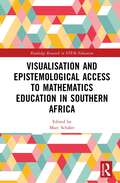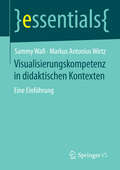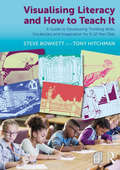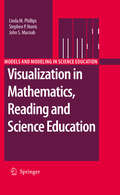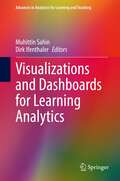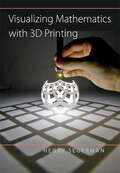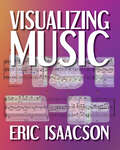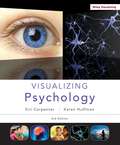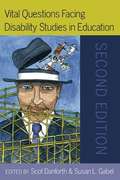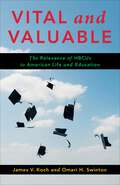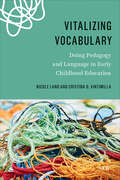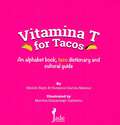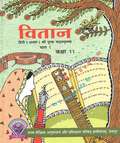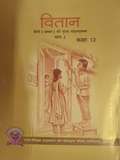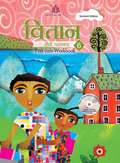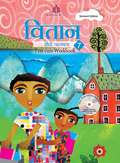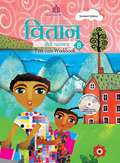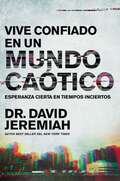- Table View
- List View
Visualisation and Epistemological Access to Mathematics Education in Southern Africa (Routledge Research in STEM Education)
by Marc SchäferThis book demonstrates that using visualisation processes in mathematics education can help to enhance teaching and learning and bridge the inequality gap that exists between well-resourced and under-resourced schools in Southern Africa. Drawing on classroom research conducted in the Southern African region, it examines how epistemological access in a context of gross inequality can be constructively addressed by providing research-based solutions and recommendations. The book outlines the visualisation process as an integral but often overlooked process of mathematics teaching and learning. It goes beyond the traditional understanding of visualisation processes such as picture forming and using tools and considers visualisation processes that are semiotic in nature and includes actions such as gestures in combination with language. It adds value to the visualisation in mathematics education research discourse and deliberation in Africa. With a unique focus on Southern Africa and open avenues for further research and collaboration in the region, it will be a highly relevant reading for researchers, academics and post-graduate students of mathematics education, comparative education and social justice education.
Visualisierungskompetenz in didaktischen Kontexten: Eine Einführung (essentials)
by Sammy Wafi Markus Antonius WirtzSammy Wafi und Markus Wirtz klären die Bedeutung von Visualisierungskompetenz von Lehrenden und Lernenden für Lernprozesse in (multi-)medialen Lernumwelten sowie multimedial geprägten Lebens- und Arbeitswelten. In diesem Essential ordnen sie Visualisierungskompetenz unter Einbeziehung des internationalen Diskurses zu Visual Literacy theoriebasiert ein. Dies schafft die Basis für die (Weiter-)Entwicklung empirisch validierter Modelle, didaktischer Materialien und Lehr-/Lernstrategien zur gezielten Förderung von Visualisierungskompetenz. Der enge Zusammenhang zur Kompetenzorientierung und Evidenzbasierung des deutschen Bildungssystems sowie Konsequenzen für didaktische Lehr- und Lernumgebungen werden verdeutlicht.
Visualising Literacy and How to Teach It: A Guide to Developing Thinking Skills, Vocabulary and Imagination for 9-12 Year Olds
by Steve Bowkett Tony HitchmanTechnological advances and the way young people interact with them means children are thinking and processing information in an increasingly visual manner. Visualising Literacy and How to Teach It recognises that many, if not most, children are attracted to visual images and uses this as a basis for introducing and developing a range of thinking skills and strategies for learning. This practical resource offers a selection of visuals, each accompanied by activities that give children practice in using their imaginations in different ways. Visualising Literacy and How to Teach It not only explores creative and critical thinking skills but also pays close attention to the overarching thinking skill that we call imagination. The book contains around 150 practical activities that develop children’s imaginations, focussing on a range of thinking skills, including but not limited to the following: developing observational/attentional skills noticing details (focussing of attention) assimilating visual information increasing experience of inferential thinking, speculation, dealing with generalisations boosting vocabulary empowering one’s attitude towards exploring ideas learning different questioning techniques increasing the ability to empathise becoming comfortable with uncertainty and ambiguity Many of the visualisation techniques can be applied to developing different aspects of emotional resourcefulness, including empathy, positive self-image, anchoring positive thoughts and modifying negative thoughts and feelings. This is, therefore, an essential resource for any teacher or education professional who is keen on developing children’s ability to think and express their own ideas.
Visualising Physical Geography: The How and Why of Using Diagrams to Teach Geography 11–16
by Luke TaylerThis practical guide breaks down the complex and broad field of physical geography, demonstrating how diagrams can be used by teachers to effectively explain the key concepts behind many natural processes and landforms. Featuring over 200 diagrams that cover the key topics taught in Key Stage 3 and 4 Geography, the book shows teachers how they can convey age-appropriate concepts without overwhelming or oversimplifying. Supported by summaries of background knowledge, common misconceptions, questions to check understanding, and extension activities, the concepts and topics explored include: Rocks and weathering Plate tectonics Rivers Coasts Weather and climate Ecosystems Glaciation Backed by research and evidence to support the use of diagrams in the classroom, this is an essential read for any geography teacher or subject lead who wants to support their students in learning key concepts in physical geography.
Visualization in Mathematics, Reading and Science Education
by John S. Macnab Stephen P. Norris Linda M. PhillipsVisualizations--either self-created or external visual stimuli used as an aid to learning--are probably as old as learning itself. Yet surprisingly little research has been done either into how precisely they help us learn, or how to produce ones that are effective pedagogical tools. This volume, a comprehensive review of theory and research on the use of visualization in mathematics, science and reading, contrasts the two dominant theoretical paradigms of how people construct and interpret visualizations. However, the authors never lose sight of practical applications, providing frequent, accessible synopses of research findings in addition to succinct summaries of how the research affects practice. Written by a team with decades of experience in research and practice in the three subjects, the chapters show how cognitive psychology can enhance practical pedagogy, place visualizations in their proper historical context, and analyze in detail the effectiveness of paper-, computer- and video-based visualizations, with some surprising results. The book is published at a time when, it seems, there is no limit to the art of creating visualizations, as powerful computers make graphics ever more colorful and realistic and 'interactivity' is firmly established as a buzzword in the educational lexicon. The aim of the volume is to explore some central questions in the field, including how to evaluate visualizations and whether or not they can act as an aid to reading development, and to mathematics and science learning. The authors also point to potentially fruitful subjects for future research, and offer their own conclusions and recommendations. As the debate continues over the value of visualizations, with polarized arguments on the one hand lauding them and on the other dismissing them as gimmicks, this book introduces a voice of reason to the discussion that will be welcomed by psychologists and educationalists alike.
Visualizations and Dashboards for Learning Analytics (Advances in Analytics for Learning and Teaching)
by Dirk Ifenthaler Muhittin SahinThis edited volume fills the gaps in existing literature on visualization and dashboard design for learning analytics. To do so, it presents critical tips to stakeholders and acts as guide to efficient implementation. The book covers the following topics: visualization and dashboard design for learning analytics, visualization and dashboard preferences of stakeholders, learners’ patterns on the dashboard, usability of visualization techniques and the dashboard, dashboard and intervention design, learning and instructional design for learning analytics, privacy and security issues about the dashboard, and future directions of visualization and dashboard design.This book will be of interest to researchers with interest in learning analytics and data analytics, teachers and students in higher education institutions and instructional designers, as it includes contributions from a wide variety of educational and psychological researchers, engineers, instructional designers, learning scientists, and computer scientists interested in learning analytics.
Visualize Your Teaching: Understand Your Style and Increase Your Impact
by Kyle EzellVisualize Your Teaching offers a unique way of helping educators see their own teaching so they can strengthen their practice. Author Kyle Ezell uses a series of simple but compelling black and white graphics to take you through teaching’s parts, flows, and signals. He demonstrates that it’s important to be aware of what’s happening when playing distinctly different parts as you teach, depending on the context. Flows connect parts together over a lesson. He shows how to visualize the impact of how flows connect over a range of circumstances. You also need to be aware of how you respond to many different signals that appear, pushing and pulling the lesson plan. Appropriate for teachers of all grade levels and subject areas, the book provides teaching scenario prompts for you to practice playing all the parts through self-observation and opportunities for you to diagram your own teaching. As you work through the pages, you’ll be able to visualize your performance the way athletes do, becoming more in tune with yourself. With this book as your batting cage, you will be increasing your impact on students in no time!
Visualizing Mathematics with 3D Printing
by Henry SegermanThe first book to explain mathematics using 3D printed models.Winner of the Technical Text of the Washington PublishersWouldn’t it be great to experience three-dimensional ideas in three dimensions? In this book—the first of its kind—mathematician and mathematical artist Henry Segerman takes readers on a fascinating tour of two-, three-, and four-dimensional mathematics, exploring Euclidean and non-Euclidean geometries, symmetry, knots, tilings, and soap films. Visualizing Mathematics with 3D Printing includes more than 100 color photographs of 3D printed models. Readers can take the book’s insights to a new level by visiting its sister website, 3dprintmath.com, which features virtual three-dimensional versions of the models for readers to explore. These models can also be ordered online or downloaded to print on a 3D printer. Combining the strengths of book and website, this volume pulls higher geometry and topology out of the realm of the abstract and puts it into the hands of anyone fascinated by mathematical relationships of shape. With the book in one hand and a 3D printed model in the other, readers can find deeper meaning while holding a hyperbolic honeycomb, touching the twists of a torus knot, or caressing the curves of a Klein quartic.
Visualizing Mathematics: The Role of Spatial Reasoning in Mathematical Thought (Research in Mathematics Education)
by Michael T. Battista Kelly S. MixThis unique volume surveys recent research on spatial visualization in mathematics in the fields of cognitive psychology and mathematics education. The general topic of spatial skill and mathematics has a long research tradition, but has been gaining attention in recent years, although much of this research happens in disconnected subfields. This volume aims to promote interaction between researchers, not only to provide a more comprehensive view of spatial visualization and mathematics, but also to stimulate innovative new directions in research based on a more coordinated effort. It features ten chapters authored by leading researchers in cognitive psychology and mathematics education, as well as includes dynamic commentaries by mathematics education researchers on cognitive psychology chapters, and by cognitive psychologists on mathematics education chapters. Among the topics included: From intuitive spatial measurement to understanding of units. Spatial reasoning: a critical problem-solving tool in children’s mathematics strategy tool-kit. What processes underlie the relation between spatial skill and mathematics? Learning with and from drawing in early years geometry. Communication of visual information and complexity of reasoning by mathematically talented students. Visualizing Mathematics makes substantial progress in understanding the role of spatial reasoning in mathematical thought and in connecting various subfields of research. It promises to make an impact among psychologists, education scholars, and mathematics educators in the convergence of psychology and education.
Visualizing Music
by Eric IsaacsonTo feel the emotional force of music, we experience it aurally. But how can we convey musical understanding visually?Visualizing Music explores the art of communicating about music through images. Drawing on principles from the fields of vision science and information visualization, Eric Isaacson describes how graphical images can help us understand music. By explaining the history of music visualizations through the lens of human perception and cognition, Isaacson offers a guide to understanding what makes musical images effective or ineffective and provides readers with extensive principles and strategies to create excellent images of their own. Illustrated with over 300 diagrams from both historical and modern sources, including examples and theories from Western art music, world music, and jazz, folk, and popular music, Visualizing Music explores the decisions made around image creation. Together with an extensive online supplement and dozens of redrawings that show the impact of effective techniques, Visualizing Music is a captivating guide to thinking differently about design that will help music scholars better understand the power of musical images, thereby shifting the ephemeral to material.
Visualizing Psychology, 3rd Edition
by Karen Huffman Siri CarpenterVisualizing Psychology 3rd Edition helps students examine their own personal studying and learning styles with several new pedagogical aids--encouraging students to apply what they are learning to their everyday lives while offering ongoing study tips and psychological techniques for mastering the material. Most importantly, students are provided with numerous opportunities to immediately access their understanding.
Visuospatial Processing for Education in Health and Natural Sciences
by Juan C. Castro-AlonsoVisuospatial processing is key to learn and perform professionally in the domains of health and natural sciences. As such, there is accumulating research showing the importance of visuospatial processing for education in diverse health sciences (e.g., medicine, anatomy, surgery) and in many natural sciences (e.g., biology, chemistry, physics, geology). In general, visuospatial processing is treated separately as (a) spatial ability and (b) working memory with visuospatial stimuli. This book attempts to link these two research perspectives and present visuospatial processing as the cognitive activity of two components of working memory (mostly the visuospatial sketch pad, and also the central executive), which allows to perform in both spatial ability and working memory tasks. Focusing on university education in the fields of health sciences and natural sciences, the chapters in this book describe the abilities of mental rotation, mental folding, spatial working memory, visual working memory, among others, and how different variables affect them. Some of these variables, thoroughly addressed in the book, are sex (gender), visualizations, interactivity, cognitive load, and embodiment. The book concludes with a chapter presenting VAR, a battery of computer-based tests to measure different tasks entailing visuospatial processing. With contributions by top educational psychologists from around the globe, this book will be of interest to a broad array of readers across the disciplines.
Visuospatial Reasoning
by Kay OwensThis book develops the theoretical perspective on visuospatial reasoning in ecocultural contexts, granting insights on how the language, gestures, and representations of different cultures reflect visuospatial reasoning in context. For a number of years, two themes in the field of mathematics education have run parallel with each other with only a passing acquaintance. These two areas are the psychological perspective on visuospatial reasoning and ecocultural perspectives on mathematics education. This volume examines both areas of research and explores the intersection of these powerful ideas. In addition, there has been a growing interest in sociocultural aspects of education and in particular that of Indigenous education in the field of mathematics education. There has not, however, been a sound analysis of how environmental and cultural contexts impact visuospatial reasoning, although it was noted as far back as the 1980s when Alan Bishop developed his duality of visual processing and interpreting visual information. This book provides this analysis and in so doing not only articulates new and worthwhile lines of research, but also uncovers and makes real a variety of useful professional approaches in teaching school mathematics. With a renewed interest in visuospatial reasoning in the mathematics education community, this volume is extremely timely and adds significantly to current literature on the topic.
Vital Directions for Mathematics Education Research
by Keith R LeathamThis book provides a collection of chapters from prominent mathematics educators in which they each discuss vital issues in mathematics education and what they see as viable directions research in mathematics education could take to address these issues. All of these issues are related to learning and teaching mathematics. The book consists of nine chapters, seven from each of seven scholars who participated in an invited lecture series (Scholars in Mathematics Education) at Brigham Young University, and two chapters from two other scholars who are writing reaction papers that look across the first seven chapters. The recommendations take the form of broad, overarching principles and ideas that cut across the field. In this sense, this book differs from classical "research agenda projects," which seek to outline specific research questions that the field should address around a central topic.
Vital Questions Facing Disability Studies in Education
by Susan L. Gabel; Scot DanforthVital Questions Facing Disability Studies in Education provides an overview and introduction to the growing field of disability studies in education, including the application of the interdisciplinary field of disability studies to inclusive education, teacher education, educational research, and educational policy development.
Vital and Valuable: The Relevance of HBCUs to American Life and Education (Black Lives in the Diaspora: Past / Present / Future)
by James V. Koch Omari H. SwintonHistorically Black colleges and universities (HBCUs) are a crucial element of higher education in the United States. As of 2021, there were more than 100 HBCUs, with a total enrollment of approximately 300,000 students. Many of the most famed figures in African American history attended HBCUs, and the alumni of these institutions have a strong track record of upward mobility and professional attainment. However, the value and contributions of HBCUs are too often overlooked and underappreciated.In Vital and Valuable, two distinguished economists provide a groundbreaking analysis of HBCUs. James V. Koch and Omari H. Swinton give a balanced assessment of the performance of HBCUs, examining metrics such as admissions and enrollment trends, graduation and retention rates, administrative expenses, spending on intercollegiate athletics, and student debt. They emphasize the distinctive features that make HBCUs what they are, considering whom they serve and how, while contextualizing these institutions within the landscape of American higher education.Based on this analysis, Koch and Swinton offer actionable policy recommendations that can help HBCUs build on their successes and address their weaknesses. They stress that empirical data on educational outcomes is essential to effective leadership of individual institutions as well as policy decisions that affect HBCUs. Vital and Valuable is essential reading for policy makers and experts in the field of higher education as well as a broader public interested in understanding the contributions of HBCUs.
Vitalizing Vocabulary: Doing Pedagogy and Language in Early Childhood Education
by Nicole Land Cristina D. VintimillaThinking with language as a complex practice for educators, advocates, and researchers in early childhood education is a necessary gesture for countering the anti-intellectualism that designates early childhood education as a service providing custodial care. Vitalizing Vocabulary insists that early childhood education in Canada must unsettle our inherited demand for technocratic, instrumental, and accessible relations with language. At the collision of research and practice, Nicole Land and Cristina D. Vintimilla propose that cultivating playful, speculative, inventive, accountable, and answerable relations with words, concepts, and language is a critical move toward broadening early childhood education’s intellectual and interdisciplinary horizons. The book is organized into four actions that activate pedagogical grammars: reading, writing, citing, and speaking. Each section plays with the purposes of a glossary by proposing language that we would work to erase, reclaim, and introduce. This situates language as an ethical, political, and creative pedagogical process that puts specific relations, curricula, and subjectivities into motion. Vitalizing Vocabulary ultimately envisions a project of early childhood education where students, educators, pedagogists, researchers, community, and others share a common commitment to creating responsive, meaningful, ethical, and political pedagogies.
Vitamina T for Tacos
by Mando Rayo and Suzanne Garcia-MateusVitamina T for Tacos explores nuestra comida, cultura and places in Latino + Latina vecindarios, neighborhoods, parques y plazas. From the tacos we all grew up eating like barbacoa and huevos con chorizo, places in and around our neighborhoods like taquerias, trucks and cultural references that empower our children to embrace their Mexican and Latinx identities and roots. Nuestra comida is connected to special places in our communities and includes food we all grew up with that everyone can enjoy and learn from. This book is an alphabet book, a taco dictionary, a cultural guide and a reminder of the importance of tacos, places y la cultura Latina. Vitamina T for Tacos is a part of a book series that explores food, places y cultura. Vitamina T is for tacos, the cultural superpower that we get from embracing nuestra comida y cultura.
Vitan Bhag 1 class 11 - S.C.E.R.T Raipur - Chhattisgarh Board: वितान भाग-1 कक्षा 11 - एस.सी.ई.आर.टी. रायपुर - छत्तीसगढ़ बोर्ड
by Raipur C. G. Rajya Shaikshik Anusandhan Aur Prashikshan Parishadवितान भाग 1 कक्षा 11 वी का राज्य शैक्षिक अनुसंधान और प्रशिक्षण परिषद् छत्तीसगढ़ रायपुर ने पुस्तक हिंदी भाषा में प्रकाशित किया गया है । ग्यारहवी कक्षा में हिंदी (आधार) पढ़ने वाले विद्यार्थियों के लिए वितान भाग 1 की परिकल्पना की गई तो भाषा, देश, विधा, आकार पर गहनता से विचार किया गया। इस किताब में कुल चार रचनाएँ संग्रहीत हैं। चारों रचनाएँ मिलकर एक नया संसार रचती हैं। इस नयी रचावट को कथ्य और शिल्प दोनों स्तरों पर देखा जा सकता है। चयन में इसका खयाल रहा है कि विद्यार्थी छोटी रचनाओं के साथ-साथ एक लंबी रचना (आलो-आँधारि) का आनंद लें और उन्हें लंबी रचनाओं को पढ़ने का चस्का लगे।
Vitan Bhag 2 class 12 - S.C.E.R.T Raipur - Chhattisgarh Board: वितान भाग 2 कक्षा 12 - एस.सी.ई.आर.टी. रायपुर - छत्तीसगढ़ बोर्ड
by Raipur C. G. Rajya Shaikshik Anusandhan Aur Prashikshan Parishadवितान भाग 2 कक्षा 12 वी का राज्य शैक्षिक अनुसंधान और प्रशिक्षण परिषद् छत्तीसगढ़ रायपुर ने पुस्तक हिंदी भाषा में प्रकाशित किया गया है । बारहवीं कक्षा में हिंदी (आधार) पढ़ने वाले विद्यार्थियों के लिए वितान भाग 2 की परिकल्पना की गई तो भाषा, देश, विधा, आकार पर गहनता से विचार किया गया। किसी भी प्रकार की सीमा आड़े नहीं आई और रचनाएँ ऐसी चुनी गईं जो रुचिकर होने के साथ-साथ विशाल दुनिया के अतीत, वर्तमान और भविष्य से बच्चों को साक्षात्कार करा सकें। इस पुस्तक में कुल चार रचनाएँ हैं। ये आकार में लंबी हैं। आत्मकथात्मक उपन्यास अंश और एक लंबी डायरी के कुछ पन्ने भी दिए गए हैं। ये वे रचनाएँ हैं जिन्हें स्वतंत्र रूप में पढ़ने के साथ-साथ पूरी रचना को पढ़ने की चाह पैदा होगी।
Vitana Hindi Pathamala class 6: वितान हिंदी पथमाला कक्षा 6
by Vikas Publishing House Pvt. Ltd.यह शृंखला पाठ्य पुस्तक और अभ्यास पुस्तिका (Text-cum-Workbook) का मिला-जुला रूप है।
Vitana Hindi Pathamala class 7: वितान हिंदी पथमाला कक्षा 7
by Vikas Publishing House Pvt. Ltd.यह शृंखला पाठ्य पुस्तक और अभ्यास पुस्तिका (Text-cum-Workbook) का मिला-जुला रूप है।
Vitana Hindi Pathamala class 8: वितान हिंदी पथमाला कक्षा 8
by Vikas Publishing House Pvt. Ltd.यह शृंखला पाठ्य पुस्तक और अभ्यास पुस्तिका (Text-cum-Workbook) का मिला-जुला रूप है।
Vive confiado en un mundo caótico: Esperanza cierta en tiempos inciertos
by Dr. David JeremiahEl autor best seller del New York Times, el Dr. David Jeremiah, actualiza su libro clásico,nos brinda sabiduría para el fin de los tiempos en Vive confiado en un mundo caótico Living with Confidence in a Chaotic World, que ofrece instrucciones prácticas y basadas en la Biblia para vivir una vida segura en un mundo lleno de caos y crisis.«No dejes que tu corazón esté preocupado...»La confianza puede ser difícil de conseguir en estos días. La gente está perdiendo sus trabajos, sus casas y los ahorros de toda su vida a un ritmo sin precedentes. La violencia, los desastres naturales y la depravación moral parecen estar disparándose. En medio de todo este caos, necesitamos saberlo... ¿Qué exactamente deberíamos hacer ahora?David Jeremiah trae un mensaje de esperanza y confianza del invaluable consejo de la Palabra de Dios. Responde nuestras preguntas más urgentes, que incluyen:¿Cómo podemos pasar esta tormenta con un corazón tranquilo?¿Qué significa realmente «esperar en el Señor»?¿Qué le está diciendo Jesús a nuestro mundo caótico de hoy?¿Cómo es que nos metimos en este lío?¿Podemos tomar un mundo quebrantado y reconstruirlo en algo fructífero?Living with Confidence in a Chaotic WorldNew York Times bestselling author, Dr. David Jeremiah updates his classic book,presents us with endtime wisdom in Living with Confidence in a Chaotic World, offering which offers biblically based, practical instruction for living a confident life in a world filled with chaos and crisis.&“Let not your heart be troubled . . .&”Confidence can be hard to come by these days. People are losing their jobs, their houses, and their life savings at an unprecedented rate. Violence, natural disasters, and moral depravity seem to be skyrocketing. In the midst of all this chaos, we need to know . . . what on earth should we do now?David Jeremiah brings a message of hope and confidence from the priceless counsel of the Word of God. He answers our most urgent questions, including:How can we weather this storm with a calm heart?What does it truly mean to &“wait on the Lord&”?What is Jesus saying to our chaotic world today?How on earth did we get into this mess?Can we take a broken world and rebuild it into something fruitful?
Vivi Loves Science (Loves Science)
by Kimberly Derting Shelli R. JohannesVivi loves science! In this STEM-themed picture book, part of a series about girls who love science, Vivi and her classmates go on a field trip to the ocean to investigate tide pools. A must-have for fans of Rosie Revere, Engineer and What Do You Do with an Idea? and anyone who loves to ask questions and learn about the world. Features a glossary and fun tide pool activity to do at home.In the companion to Cece Loves Science and Libby Loves Science, Vivi and her classmates take a field trip to the beach to study tide pools. With help from her teacher and a park ranger, Vivi and her friends make aquascopes, participate in a marine-inspired scavenger hunt, and learn about different species that call the ocean home.At the end of their trip, there’s one more surprise for Vivi! Full of fun facts about marine biology and conservation, Vivi Loves Science is a perfect pick for aspiring scientists, classrooms, and fans of Andrea Beaty’s Ada Twist, Scientist.Features a glossary and instructions on how to make your own aquascope and tide pool at home.
